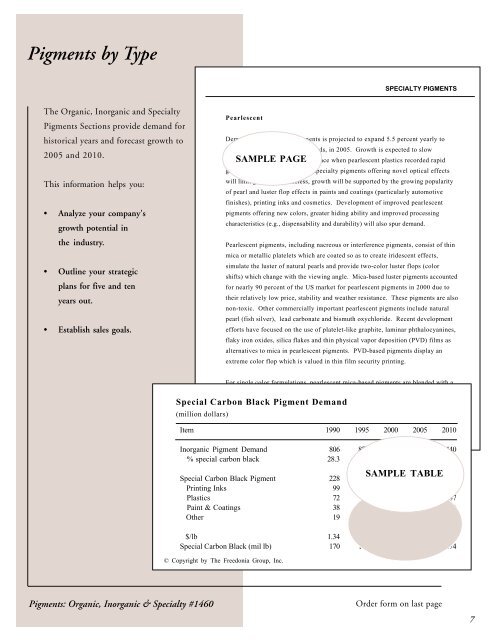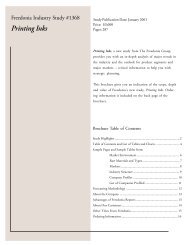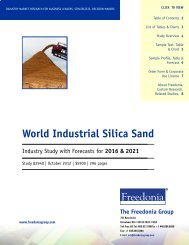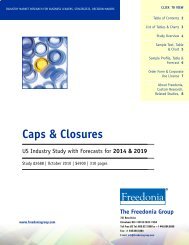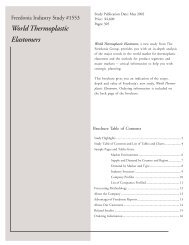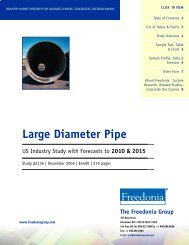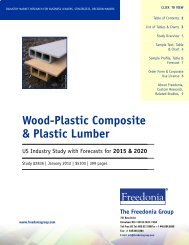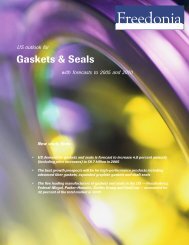Pigments: Organic, Inorganic & Specialty - The Freedonia Group
Pigments: Organic, Inorganic & Specialty - The Freedonia Group
Pigments: Organic, Inorganic & Specialty - The Freedonia Group
You also want an ePaper? Increase the reach of your titles
YUMPU automatically turns print PDFs into web optimized ePapers that Google loves.
<strong>Pigments</strong> by TypeSPECIALTY PIGMENTS<strong>The</strong> <strong>Organic</strong>, <strong>Inorganic</strong> and <strong>Specialty</strong><strong>Pigments</strong> Sections provide demand forhistorical years and forecast growth to2005 and 2010.This information helps you:• Analyze your company'sgrowth potential inthe industry.• Outline your strategicplans for five and tenyears out.• Establish sales goals.PearlescentDemand for pearlescent pigments is projected to expand 5.5 percent yearly to$127 million, or ten million pounds, in 2005. Growth is expected to slowSAMPLE PAGEmoderately from the 1995-2000 pace when pearlescent plastics recorded rapidgains. Competition with other specialty pigments offering novel optical effectswill limit gains. Nevertheless, growth will be supported by the growing popularityof pearl and luster flop effects in paints and coatings (particularly automotivefinishes), printing inks and cosmetics. Development of improved pearlescentpigments offering new colors, greater hiding ability and improved processingcharacteristics (e.g., dispensability and durability) will also spur demand.Pearlescent pigments, including nacreous or interference pigments, consist of thinmica or metallic platelets which are coated so as to create iridescent effects,simulate the luster of natural pearls and provide two-color luster flops (colorshifts) which change with the viewing angle. Mica-based luster pigments accountedfor nearly 90 percent of the US market for pearlescent pigments in 2000 due totheir relatively low price, stability and weather resistance. <strong>The</strong>se pigments are alsonon-toxic. Other commercially important pearlescent pigments include naturalpearl (fish silver), lead carbonate and bismuth oxychloride. Recent developmentefforts have focused on the use of platelet-like graphite, laminar phthalocyanines,flaky iron oxides, silica flakes and thin physical vapor deposition (PVD) films asalternatives to mica in pearlescent pigments. PVD-based pigments display anextreme color flop which is valued in thin film security printing.For single color formulations, pearlescent mica-based pigments are blended with atransparent color-producing pigment, or combined in a two- layer coating systemSpecial Carbon with one Black containing Pigment the pearlescent Demand pigment and the other containing the color(million dollars) formulation. For more brilliant colors with sharper color flops, mica platelets areItemcoated with a thin layer of titanium oxide or other transparent inorganic or1990 1995 2000 2005organic colorant. Transparent metal oxide coatings, for example, produce2010<strong>Inorganic</strong> Pigment Demand 806 879 1025 1210 1440% special carbon black 28.3 30.7 30.2 30.4 30.4Special Carbon Black Pigment 228 270 310 368 438Printing Inks 99 120 138 164 195Plastics 72 85 92 114 137Paint & Coatings 38 45 52 61 70Other 19 20 28 29 36$/lb 1.34 1.40 1.45 1.52 1.60Special Carbon Black (mil lb) 170 193 214 242 274© Copyright by <strong>The</strong> <strong>Freedonia</strong> <strong>Group</strong>, Inc.SAMPLE TABLE<strong>Pigments</strong>: <strong>Organic</strong>, <strong>Inorganic</strong> & <strong>Specialty</strong> #1460Order form on last page7


